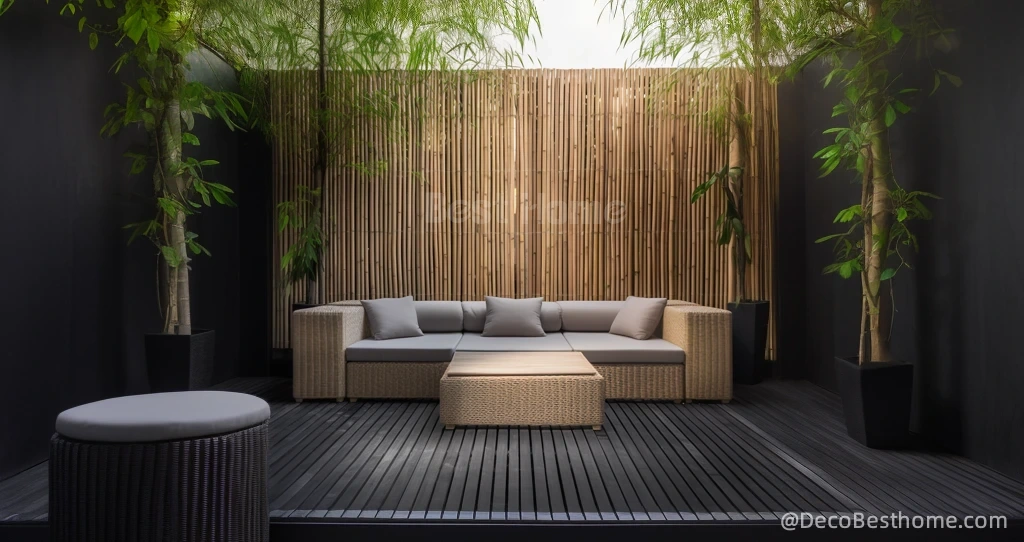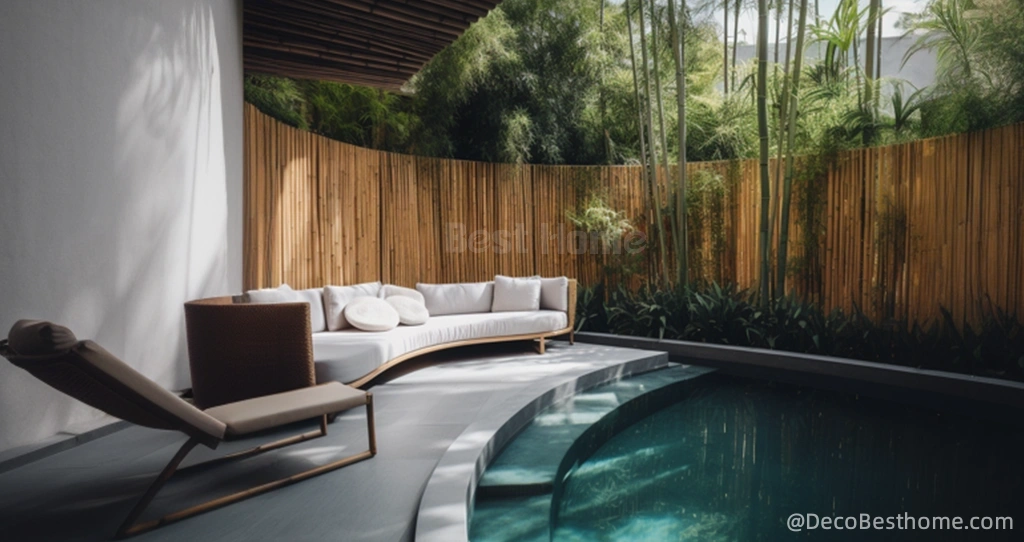How to Choose the Right Bamboo Fence for Your Outdoor Space

How to Choose the Right Bamboo Fence for Your Outdoor Space
Bamboo fencing is more than just a boundary for your property; it is an extension of your home's style and a representation of your personal aesthetic. Choosing the right bamboo fence requires a thoughtful decision about how it will complement your garden and outdoor living space. Below we delve into how to integrate bamboo fencing creatively and harmoniously within various landscape designs.
What is Bamboo and Why Choose It for Fencing?
Bamboo is not just a plant; it's a remarkably versatile resource. Technically classified as a grass, bamboo can grow at an astonishing rate, some species shooting up as much as three feet within 24 hours! Due to its rapid growth, bamboo is an excellent candidate for sustainable harvesting, making it an eco-friendly alternative to traditional lumber.
In the context of fencing, bamboo offers several advantages:
- Sustainability: As a fast-growing, renewable resource, bamboo reduces our reliance on slow-growing hardwoods, helping to preserve forests.
- Strength: Certain species of bamboo have tensile strength comparable to steel and greater compressive strength than many mixtures of concrete.
- Versatility: Bamboo can be crafted into various styles to suit any garden or landscape design.
- Ease of Installation: Lightweight and user-friendly, bamboo fencing materials are easy for homeowners to work with, whether as a DIY project or professionally installed.
Different Species of Bamboo Used for Fences
Not all bamboo is created equal. When selecting bamboo for fencing, it's essential to choose species known for their durability and strength. Here are a few commonly used for making bamboo fences:
- White bamboo Commonly used in construction and known for its straightness and uniformity, White bamboo is ideal for creating elegant fences with a clean, consistent look.
- Tonkin Bamboo (Pseudosasa amabilis): Commonly used in construction and known for its straightness and uniformity, Tonkin bamboo is ideal for creating elegant fences with a clean, consistent look
- Black Bamboo (Phyllostachys nigra): Valued for its striking appearance, black bamboo offers a unique look with its distinctive dark-colored culms, creating a stunning visual contrast in the garden.
- Moso Bamboo (Phyllostachys edulis): One of the most popular and widely cultivated species for commercial use, Moso bamboo is known for its thickness, strength, and versatility.
The Environmental Benefits of Choosing Bamboo
- The environmental benefits of using bamboo for fencing can't be overstated. A substantial benefit is its ability to grow without the need for pesticides or fertilizers, reducing the chemical run-off into the environment. Additionally, bamboo's extensive root systems can help prevent soil erosion in sensitive areas. Bamboo also absorbs carbon dioxide and releases 35% more oxygen into the atmosphere than an equivalent mass of trees, purifying the air that we breathe.
- Bamboo's eco-credentials extend further when considering its role in combating climate change. As a carbon sink, bamboo forests can effectively sequester carbon at a higher rate than some tree species. When harvested and used for products like fencing, the carbon remains trapped in the bamboo, preventing it from returning to the atmosphere.
- In summary, bamboo fencing is not merely a means to define the boundaries of your outdoor space; it's a conscious choice that supports a more sustainable way of living. The path towards a greener future can often start in our own backyards, and by choosing bamboo, you are part of a growing movement towards eco-friendly, sustainable home improvement. As you contemplate the next steps in selecting the right bamboo fence for your haven, consider the extraordinary traits of this remarkable material - its environmental impact, its strength and beauty, and its diversity, which ensures there is a bamboo fence for every style and necessity

Matching Your Fence to the Garden Style
The beauty of bamboo is its versatility. Whether your garden is a serene Oriental Zen retreat, a lush tropical oasis, or a modern minimalist space, there’s a bamboo fence design to enhance the theme.
- Oriental Zen Gardens: A traditional oriental garden often features a simplistic and natural aesthetic, where each element is thoughtfully placed and serves a purpose. A bamboo fence in such a setting is not just a barrier but a part of the scenery. Opt for a bamboo cane fence with clean lines and natural hues to complement the tranquillity of a Zen-inspired garden.
- Tropical Themed Gardens: To evoke the feel of a tropical retreat, a robust bamboo fence with a thicker, more rugged look can add to the verdant atmosphere. The natural patterns of bamboo can complement rich green foliage, vibrant flowers, and water features.
- Contemporary Outdoor Spaces: Modern landscapes with minimalist designs can benefit from a sleek bamboo slat fence that provides privacy with a refined, linear structure that complements geometric garden layouts and clean architectural lines.
Decorative Tips for Integrating Bamboo Fencing into the Landscape
Creativity is key when integrating your bamboo fencing into your existing landscape. Consider using bamboo panels as a backdrop for a splash of colorful plants or as a contrasting texture against smooth hardscapes like stone pathways and sleek patio furniture. Bamboo's natural color variations can also provide an organic canvas for outdoor lighting, which can be used to highlight the fence and create ambiance in the evening.
For a dynamic visual effect, consider combining bamboo with other natural elements like climbing plants or vines, which can weave through the fencing, giving it a living wall feel. These collaborations not only enhance aesthetic appeal but can also create habitats for local wildlife, contributing to ecosystem health.
Incorporation with Other Materials for Unique Designs
Beyond the standalone appearance of bamboo fences, they can also be paired with other materials to produce striking visual effects. You can frame bamboo panels with wooden posts for a sturdy and contrasting look, or combine them with wrought iron accents for a blend of organic and industrial elements. Stone bases for bamboo fencing not only add an extra layer of design but can also protect the bamboo from direct contact with soil, thereby preventing potential decay and increasing longevity.
When integrating materials, ensure they harmonize with both the bamboo and the surrounding space. The natural tones of the bamboo should complement, not clash with, other elements in your garden. The goal is to achieve balance, where the combination of materials enhances the overall appearance and functionality of the fencing.
Choosing the right bamboo fence style not only sets the tone for your garden’s design but also defines the way you interact with your outdoor space. With these style and aesthetic considerations in mind, selecting the right bamboo fence is not only a practical decision for privacy and security but a considerable contribution to the natural beauty and harmony of your home's exterior sanctuary.
Regular Cleaning and Care for Longevity
Keeping your bamboo fence clean is crucial for its maintenance. Over time, bamboo can collect dirt, debris, and algae which can compromise its integrity and aesthetic. To clean your bamboo fence:
- Use a soft brush or cloth to wipe down the bamboo.
- Employ a mild soap or bamboo-specific cleaner and water to gently scrub away any build-up.
- Rinse the fence thoroughly with a garden hose, avoiding high-pressure settings that may damage the bamboo.
- For more stubborn stains or mildew, a solution of vinegar and water or a mixture of bleach and water (use sparingly) can be applied, but always spot test first to ensure it doesn't damage the bamboo.
Regular cleaning not only keeps your fence looking great but also allows you to inspect the material for any signs of damage or wear, addressing minor issues before they become bigger problems.
Understanding the Treatment Process for Durability and Longevity
One of the key factors in the durability of a bamboo fence is the treatment process it undergoes before being sold. Bamboo, by its nature, is a hardy material, but it's susceptible to insects and weathering if not properly treated. Typically, high-quality bamboo fencing will go through a process of curing, which may include kiln drying and treatment with borates or other environmentally-friendly preservatives to prevent decay, mold, and insect infestation. A well-treated bamboo fence can last over 10 years with proper maintenance, so it is essential to check with the seller about the treatments applied to their bamboo fencing products.
The Importance of Thickness and Density
Thickness and density are vital attributes to consider when choosing bamboo fencing. Thicker and denser bamboo canes tend to be more durable and less prone to cracking or splitting. Most high-quality fences use bamboo canes with a diameter of at least 1 inch, though the precise thickness needed may vary based on the height and length of the fence, as well as local weather conditions. Additionally, fencing made from White bamboo, known for its density and strength, is particularly sought after for durable outdoor applications.
Signs of Quality Craftsmanship in Manufactured Bamboo Fences
Quality craftsmanship in bamboo fencing can be the difference between a fence that stands the test of time and one that does not. Key indicators include uniformity in cane size, consistency in color, and smoothness of cut edges which prevent moisture accumulation and potential rot. Joints should be well bound, and any metal hardware used in the construction should be galvanized or stainless steel to prevent rust. A sign of a meticulously crafted bamboo fence is the attention to detail such as capped tops on the bamboo poles to prevent water from entering and sturdy frames that support the structure of the fence.
When it comes to assessing the quality and durability of bamboo fencing, it's crucial to do your due diligence. Look for reputable suppliers who offer transparency about their sourcing and treatment process, and check for customer reviews or testimonials regarding the longevity of their fencing products. Furthermore, inquire about any warranties or guarantees that may cover your bamboo fencing for a certain period after purchase – this not only provides peace of mind but also is a testament to the confidence suppliers may have in the durability of their product.
Remember, choosing the right bamboo fence isn't just about aesthetics—it's a balance between beauty, durability, and sustainability. Take the time to evaluate the quality and you'll find a fence that not only looks fantastic but also stands strong in the face of time and the elements. Your outdoor space deserves a bamboo fence that maintains its integrity and continues to provide privacy and enjoyment for years to come.
Treating and Coating Your Bamboo Fence to Resist Weathering
To further protect your bamboo fence from weather and UV damage, consider applying a water-resistant sealant. This should be done initially upon installation and then reapplied every 1-2 years, depending on your climate and the product used. A UV-resistant bamboo protector and rejuvenator can also be applied to help maintain the natural color of the bamboo, or you might opt for a tinted stain to achieve a desired hue.
When choosing treatments, ensure they are suitable for outdoor use and safe for plants and animals if your fence is within reach of your garden or pets. Always follow the manufacturer’s instructions for the best results.
